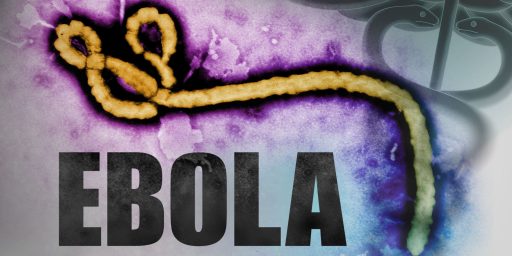Federal Bureaucrats Repeatedly ‘Warned’ About Pandemic Shortages
But they weren't shouting it from the rooftops.

President Trump campaigned pledging to “drain the swamp” and has spent much of his administration railing against the “Deep State.” But professional civilian servants have been warning about the present crisis for years.
CNN (“Federal officials repeatedly warned that US hospitals lacked enough ventilators“):
In at least 10 government reports from 2003 to 2015, federal officials predicted the United States would experience a critical lack of ventilators and other lifesaving medical supplies if it faced a viral outbreak like the one currently sweeping the country.
The drumbeat of warnings undermines President Donald Trump’s claim last week that “nobody in their wildest dreams” could have imagined the demand for ventilators that now exists. The demand is pushing hospitals to the brink in New York City and threatening to do so in parts of Washington state, California, Louisiana and beyond.
In addition, a 2017 study funded by the National Institutes of Health and the Centers for Disease Control and Prevention found that “substantial concern exists that intensive care units (ICUs) might have insufficient resources to treat all persons requiring ventilator support” and that even the supplies held in the so-called Strategic National Stockpile “might not suffice to meet demand during a severe public health emergency.”
But federal agencies were underscoring the risks of insufficient ventilators and other equipment as far back as President George W. Bush’s administration. In July 2003, a report by the Government Accountability Office noted that “few hospitals reported having the equipment and supplies needed to handle a large-scale infectious disease outbreak. Half the hospitals we surveyed had, for every 100 staffed beds, fewer than 6 ventilators, 3 or fewer personal protective equipment suits, and fewer than 4 isolation beds.”
[…]
“There has always been a concern about a respiratory illness, readily transmittable, emerging as an infectious disease,” said Marcia Crosse, who worked at the GAO from 1983 to 2018, most recently as the director of health care.
During global outbreaks of H1N1, SARS and MERS, Crosse said, “we dodged the bullet time and again.”
“But the CDC has been well aware, HHS has been well aware, the intelligence community has been well aware” of the risk, she added. “Of course, nobody would know the specific details, we didn’t know it would be a coronavirus from China, but the threat of a respiratory illness was known.”
The report lists and links several of the reports in question:
- A May 2003 GAO report found that “few hospitals have adequate medical equipment, such as the ventilators that are often needed for respiratory infections … to handle the large increases in the number of patients that may result” from an infectious disease outbreak.
- A November 2005 Congressional Research Service report cautioned about a possible H5N1 avian flu pandemic: “If this strain were to launch a pandemic … large numbers of victims may require intensive care and ventilatory support, likely exceeding national capacity to provide this level of care.”
- That same month, the Department for Health and Human Services published a Pandemic Influenza Plan, which said: “Despite planning and preparedness, however, in a severe pandemic it is possible that shortages, for example of mechanical ventilators, will occur and medical care standards may need to be adjusted to most effectively provide care and save as many lives as possible.”
- A July 2006 report by the Congressional Budget Office sent to Senate leaders stated, “CBO’s December assessment noted that the United States has approximately 100,000 ventilators, with three-quarters of them in use on any given day. According to HHS, a severe influenza pandemic like the one in 1918 would require 750,000 ventilators to treat victims.”
- The Defense Department in its August 2006 Implementation Plan for Pandemic Influenza: “Considerable demand for ventilators is likely, especially in the event that the pandemic occurs before a vaccine is available. Where feasible, consideration should be given to stockpiling instead of “just-in-time” acquisition of adequate numbers of ventilators, antiviral drugs, and other medical supplies including Personal Protective Equipment (PPE).
- In November 2007, an Interior Department pandemic influenza plan stated: “Health care facilities will likely (be) overwhelmed, creating a shortage of hospital staff, beds, ventilators, and other supplies.
- A 2009 Occupational Safety and Health Administration publication noted: “Healthcare facilities can be overwhelmed, creating a shortage of hospital staff, beds, ventilators and other supplies..
- An August 2009 report by the Executive Office to the President related to preparations for a H1N1 outbreak said: “During the peak, 1 or 2 out of every 2,000 Americans might be hospitalized. Cases requiring mechanical ventilation or intensive care could reach 10 to 25 per 100,000 population, requiring 50 to 100 percent or more of the total ICU capacity available in the United States and placing great stress on a system that normally operates at 80 percent of capacity.”
- A 2015 study by researchers from the Department of Health and Human Services and Center for Disease Control and Prevention modeled the need for ventilators during an influenza outbreak, calculating that “an additional 7000 to 11,000 ventilators will be needed, averting a pandemic total of 35,000 to 55,000 deaths. A 30% CAR [clinical attack rate], high severity scenario, will need approximately 35,000 to 60,500 additional ventilators, averting a pandemic total 178,000 to 308,000 deaths.”
Several things jump out at me here.
First, while Trump has been especially negligent on this matter both ahead of and during the crisis, the problems have been brewing for a long time.
Second, ten reports over seventeen years is . . . not a lot. Here is a list of reports released by the GAO alone over the past week:
- Department of Justice: ATF and U.S. Marshals Service Can Further Strengthen Controls over Employee Misconduct Processes
- Science & Tech Spotlight: 5G Wireless
- Defense Nuclear Enterprise: Systems Face Sustainment Challenges, and Actions Are Needed to Effectively Monitor Efforts to Improve the Enterprise
- Drug Misuse: Sustained National Efforts Are Necessary for Prevention, Response, and Recovery
- Military Housing: DOD Needs to Strengthen Oversight and Clarify Its Role in the Management of Privatized Housing
- Patient-Centered Outcomes Research Institute: Review of the Audit of the Financial Statements for FY 2019
- Aviation: FAA Needs to Better Prevent, Detect, and Respond to Fraud and Abuse Risks in Aircraft Registration
- Navy Shipbuilding: Increasing Focus on Sustainment Early in the Acquisition Process Could Save Billions
- Intergovernmental Issues: Key Trends and Issues Regarding State and Local Sector Finances
- National Transportation Safety Board: More Detail Could Increase the Understanding of Selections for the Most Wanted List of Transportation Safety Improvements
That’s ten reports in just a single week. And likely this is a thin output, as one would imagine most GAO employees are teleworking as part of the national social distancing program.
GAO and CRS both employee solid analysts and their reports are rightly trusted by senior governmental leaders and external researchers. But, conservatively, they together issue a thousand or so reports a year. If each of those contains ten recommendations or highlight ten issues for concern—mostly unconcerned with political and fiscal tradeoffs—one can easily see how the system would be overwhelmed. And it’s not like those two agencies are the only ones in government issuing reports and white papers. Much less outside think tanks, universities, and other expert sources. Not to mention lobbyists from a boundless set of perspectives.
Presidents and Congress were simultaneously “warned” and not.
Beyond that, given competing priorities, it’s not completely obvious that they made poor choices even in the unlikely chance these ten reports each made it to the highest level of decisionmaking.
Who was it that was supposed to stock tens of millions of surplus respirators, a perishable item, in the chance a once-a-century event like this happened? In hindsight, the federal government should have had them on hand. But we have a healthcare system that flows almost entirely through the private sector.
Moreover, we clearly need far more hospital beds, doctors, nurses, and other medical professionals during surge periods. But who’s paying for them when they’re idle?
These questions are easier to answer in hindsight. Or, especially, in the context of a healthcare system that’s funded by the federal government. Indeed, in that context, a much larger pool of healthcare professionals, especially, would seem necessary as a cost-containment measure.





We have known for a long time, as your piece points out, that we were not adequately prepared if a real pandemic came along. Even the near misses of the last 20 years didn’t make us change. That said, this just isn’t an easy problem to solve. Individual hospitals cant afford to maintain stockpiles of ventilators and PPE adequate for a response. They can’t even really afford to keep people trained.
The only practical way to do this would be for the government, probably federal, to maintain stockpiles. Then the problem becomes the budget. It gets difficult to convince legislators to spend huge amounts of money for something that never happens. How do we even correctly predict how large that stockpile needs to be?
My preferred solution would be for the feds to maintain a stockpile, maybe a bit larger than we have in the past. What we really need beyond that is a dedicated team devoted to preparing for a pandemic and that their planning would include contingency plans with the private sector for ramping up production quickly. We should have already known which manufacturers were capable of quickly ramping up to make PPE gear and ventilators, and further those manufacturers should be paid to always keep plans on hand for making the conversion to making those products. (Waiting for my 0800 meeting on cross training some rapid response teams. Thanks for giving me something to do here.)
Steve
Who was it that was supposed to stock tens of millions of surplus respirators, a perishable item, in the chance a once-a-century event like this happened? In hindsight, the federal government should have had them on hand. But we have a healthcare system that flows almost entirely through the private sector.
Moreover, we clearly need far more hospital beds, doctors, nurses, and other medical professionals during surge periods. But who’s paying for them when they’re idle?
Well, now that we HAVE the benefit of hindsight, maybe the next time we have a debate about whether to give corporations and rich folks another tax cut, we remember that we had to ask these questions in 2020.
Spending $2-4 billion a month in Iraq and Afghanistan was doable. Deploying and creating bases for 100,000 plus service members and another 100,000 contractors. Nope can figure out how to prepare then react to pandemic. Just costs too much to prepare. Give me a break.
@Bruce Henry:
and @Mike:
That’s really a non sequitur. The issue isn’t one of affordability it’s one of how our system works. With some modest exceptions like the VA and DOD hospitals, we have a private healthcare system backstopped by federal spending (Medicare, Medicaid, etc.). In that context, it would have been odd for the US government to stockpile large numbers of ventilators beyond what we already stockpile. And then, what, turn around and donate them to hospitals, who will in turn charge us for using them?
And we’re going to build a shadow hospital system just in case it’s needed?
@James Joyner: Something I read the other day, I wish I could remember where (it may even have been here on OTB), had a public health professional talking about all the modeling they did in anticipation of an event like COVID-19, and the thing that jumped out at me was him basically saying “in none of our models did we ever imagine a total failure of testing.”
I mention this because I think you’re right, and wanted to add some context: if we hadn’t so utterly failed so early on, the question of having enough ventilators probably wouldn’t even have been relevant. Sadly, as it is now we’re going to be overwhelmed because we failed from the get-go.
So there’s not enough and too much.
So the government is too busy going in the wrong direction to bother reading the reports it commissions.
I don’t generally consider you a lazy writer, James, but scare quotes are exactly that. What was it you were trying to say?
@James Joyner:
From Wikipedia:
When people tell me that they don’t trust government, I suggest they trust the bureaucracy. Bureaucrats may not tell you what you want to hear, their mission and/or instructions maybe obsolete and even at variance with the presenting problem, but their recommendation will be honest, if sometimes tempered by political appointees. Anyone who has spent any time studying how bureaucracies function, knows that agencies create reports, the executive and legislature says thank you and puts the report in a file. Occasionally something catches the eye of the exec or legislative aid that supports a political position and that floats to the top.
The US was unprepared, that’s not surprising with this being a national emergency and our disaster response plans assume mutual assistance for areas not effected to the effected area. That won’t change when this is over. As @James points out our healthcare system is largely private and even the not-for-profit sector could not afford the level of preparation needed and the for profit sector wouldn’t have even considered it. Despite the US’s piss poor planning, we aren’t the only country struggling with a response. Those with universal coverage and nationalized healthcare systems (UK) are in a similar position.
None of this excuses the ineptitude and malevolence of Tiny’s response to the crisis, which has been more akin to a monkey effin a football, than military precision.
I’m sorry, but this is nonsense.
I work in a field where those GAO and CRS reports (and many others produced by independent organizations) are relevant. And I read (or at least skim) all of them that are in my area of concern, and this is not a major part of my day to day work. Aggregators and direct notices from the organizations involved point me to them efficiently. It’s just a basic part of keeping up with the field.
My wife, who is an attorney, laughs at how little reading I need to do in my work, compared to hers.
@Mikey: That. Yes, there are so many reports floating around that after the fact you can find a warning for anything. Sort of like how there’s always a Trump tweet. And no, we can’t maintain a shadow health care system. Although it would be nice if we actually had a health care SYSTEM to start with and not whatever what we have is. But once the virus broke out in China and started to spread we sure got off the dime slowly and ineptly.
@Kit:
Exactly what I said: there were warnings buried in a handful of reports. Nobody was shouting from the rooftops that this needed to be done. It’s easy in hindsight to go, “Aha! There were ten warnings! Going back to 2003!” And, indeed, that was my initial reaction. But my considered reaction is that, no, it’s really not much given how many thousands of recommendations were buried in reports over the years.
@Kit:
Yup. And it turned out to have had a bunch of expired respirators. One presumes the expiration dates are overly cautious and that they’re better than nothing but one understands the reluctance to issue them.
@Sleeping Dog:
No, I think it’s the opposite. They hate institutions like the DMV and the IRS. They hate Congress, too, but love their Congressman.
@DrDaveT:
Sure. And I’m sure professional staffers at the NSC and the various Congressional committees do the same. But getting those recommendations taken seriously by policymakers is still a massive challenge given how many of them there are.
@James Joyner:
And in my limited experience, I’ve found DMVs and the IRS reasonably efficient and courteous. My wife had foot surgery a couple months ago, so I got a form from the doctor’s office to get a temporary parking placard from the DMV. It took me three visits to each to get the placard. Entirely due to ineptitude at the doctor’s office. The DMV was quick, courteous, and helpful.
Being retired, and with my wife’s ankle, we started sheltering in place before it became a thing.
@James Joyner: “It’s easy in hindsight to go, ”
And yet, while the Republican-led government sat back and allowed massive “health” operations swallow up hospital after hospital and then start shutting them down in the name of “efficiency” — that is, profits — there were actually people who had the nerve to suggest that allowing monopolization and the single-minded pursuit of stock price to define our entire health care system would lead to negative consequences.
Of course they were entirely ignored in this post-Reagan world, because Republicans have decided that the only thing that matters is that the ownership class become richer.
@wr: We’ve had two, two-term, Democratic presidents in the mix as well as long stretches where Democrats controlled one or both Houses of Congress. It’s been a rather consistent trend.
As implied in the closing paragraph of the OP, this whole problem looks different in the context of a single-payer system. But it’s not what we have.
@James Joyner:
Which is why I tell them to trust the bureaucracy and I agree they don’t and I tell them that the bureaucrat is simply a working bloke trying to do their best, just like they do in their job.
@James Joyner: what I mean is if we mobilize that to support a war of choice/ endless occupation, we can ramp up in our own country for this and figure this out. Contingency plans made and executed when needed. Seems we are moving in that direction now, finally.
@wr:
The problem of monopsony and monopoly have become endemic in the US economy while the current anti-trust law is ill equipped to deal with it. With specific regard to healthcare delivery, there is no reason to believe that more hospital groups would result in more beds. It would result in lower prices and increased compensation to employees, but the number of beds, physicians and nurses would be determined the typical demand for beds.
@James Joyner:
Given the problem that the UK, Italy and others are having, single payer wouldn’t have helped. What would have helped was a government that reacted to the first signs of a problem and had a program in place. That should have happened in January and did in South Korea, Hong Kong and Singapore. All of which have had success in tamping down transmission, though Hong Kong and Singapore gave up controls too soon.
and
I don’t agree with this at all. You could give the same excuse for any policy area for the same reasons. If the federal government cannot walk and chew gum at the same time, then it doesn’t make much sense to give it even more responsibility, which is what you suggest with a national health service. It’s not clear to me that moving from about ~60% of government health care spending we have now to 100% solves this problem or makes pandemic response better when pandemic response hasn’t been a priority for Congress or the Executive for the past 20+ years.
The problem is really political, not technocratic or financial. It is not something that can be fixed by nationalized health care or electing Presidents more competent than Trump – it requires the Executive and Congress to make this a political priority. And, absent an actual pandemic, there are few incentives for them to do so. There’s no voting bloc for pandemic preparation, there’s little in terms of lobbying interest by business, unions or other interest parties. The fact is that clear public goods like pandemic response take a back seat to interest groups and promoting ideological goals by our political class. This is even more true in today’s highly divided, ideological, and snarky Twitter-fed politics.
As for a national stockpile, we have one, but it is not resourced to deal with a pandemic, for the same reasons. Neither party has wanted to spend the money. The best number I’ve seen is that it only has 16k ventilators, not nearly enough to plus-up the need to deal with this pandemic.
Again, this is a failure of every administration (who haven’t requested increases in their budget wish lists) and Congress, who hasn’t funded them. And it’s not like this was an unknown problem.
Preparation is not rocket science. We’ve had a decade-plus of warnings. There are interviews with Dr. Fauci and other experts from the past decade noting the danger of a global pandemic and our inability to deal with it effectively.
And I think the reality is that this is part of how people generally deal with risk combined with a sclerotic federal government. We are not very good at preparing for crises, we prioritize near term interests over long-term planning, the hear-and-now over some future rare event.
We saw something very similar with 9/11. And that combined with the anthrax scare caused our politicians to focus health preparedness for a while – a ton of grant money was given to states to enable them to prepare their first responders and health care systems. Over time, especially after the financial crisis, a lot of that funding dried up. State governments had to prioritize and funding for health response was reduced for other priorities. Same at the federal level.
That also is political and not a function of a technocratic system that is unaware of the problem because of a sea of studies and white papers.
@Mike:
And that’s because the military has robust contingency planning that has been consistently resourced. We have entire headquarters built and equipped and ready for personnel to come in an run a war or conflict on short notice. We have supplies prepositioned around the globe. We maintain a logistics infrastructure that allows global operations. We do training (though probably not enough training) to implement these plans.
The same could be done with pandemic response but our elected leaders have chosen not to do that.
@Andy:
It should be noted that military preparation only occurred after the US accepted its role as the indispensable nation in the protection and propagation of liberalism. At the beginning of WWII the US was caught virtually flatfooted though there was at minimum 2+ years of warning that war was coming.
@Andy: @Sleeping Dog: Still, the crux of the matter is in comparing how many pandemics there are compared to how many wars politicians are willing to start/fight in. The resources match the priorities almost exactly.
@Sleeping Dog:
Yep, exactly. There is robust political support for this, which is why it gets funded and resourced. Not so much for other things.
Going forward, pandemic response will probably be a priority for maybe the next decade, and then it will start to fade in importance and become neglected – a pattern we’ve seen before.
I really don’t give much credence to this excuse, and not just for Trump. A nationwide epidemic isn’t some bizarre, totally unforeseeable event that, per Trump, no one could have expected. On the contrary, it was an inevitability. It’s a regular occurrence throughout history and obviously going to be more frequent and fast-moving in the context of our modern interconnected world. I didn’t need 10 GAO reports, or 1000, or 10,000 for me to grok that well in advance of it actually happening.
People made the same excuses after Hurricane Sandy – who could have expected that a major storm would go all the way up the coast to NY/NJ? Answer: anyone who paid even the slightest attention to the historical record and current trends in Atlantic hurricanes! They made those excuses again after 9/11 – who could possibly have expected terrorists to fly planes into skyscrapers and government buildings? Again, anyone who’d been paying the slightest bit of attention. Terrorists had been hijacking planes and committing suicide bombings for decades. It was bloody obvious they were going to be combine the two tactics at some point and that skyscrapers and government buildings would be the targets of choice. Hell, Tom Clancy wrote a damn book about it 5 years earlier!
And now we’re doing the same “who could possibly have expected it” dance with COVID-19, and we’ll do it again when a major cyber attack takes down critical parts of our infrastructure, and again when a tsunami hits the Northwest coast, and again when a largish asteroid hits in a populated area, and again, and again, and again. It’s incredibly frustrating that our leaders evidently have such a universal failure of imagination and prediction that they always, always close the barn door after the horse is already out and then cry, “But who could have expected it!”
We needed a moderately larger stockpile, along with contingency plans in place to get production up and running in almost zero time, with periodic dry runs to verify the plans.
And we needed to kick off those plans months ago, rather than sitting on our hands.
Yes, the stockpiles were too low. That goes back decades. Both sides, etc.
Did we not have up to date plans for boosting production, or did Trump fuck that up? I don’t think we have an answer to that.
@James Joyner:
…their job.
@James Joyner:
Yes, it has. Those Democratic presidents spent enormous portions of their political capital trying to improve the universality and quality of healthcare. One of them failed; the other succeeded, only to have the GOP devote their entire lives to tearing down that success to build… nothing.
The trend has been entirely consistent, and your feeble effort at “both sides do it” here is beneath you.
@Sleeping Dog:
It’s not a sufficient remedy, but it certainly would have helped. Italy has way more hospital beds per resident than the US does, and that has helped them very much — just not enough.
Relevant to this discussion is this NYT article about how the government tried to build a fleet of inexpensive, easy-to-use ventilators.
Spoiler alert: the small, nimble company that was on track to meet this goal got purchased by a much bigger company, which decided it didn’t want an inexpensive product in the market competing with its existing and far more expensive ventilator.
The private market in healthcare has some benefits, and many, many shortcomings.